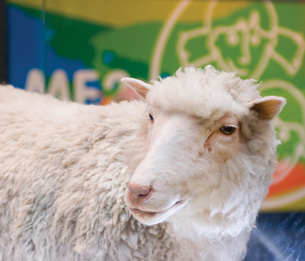Module 5
1. Module 5
1.19. Page 4
Module 5—Cell Division: The Processes of Mitosis and Meiosis
 Reflect and Connect
Reflect and Connect
Meiosis is the part of the life cycle that gives rise to variations. Through the recombination of chromosomes, random assortment during separation, and random fertilization, it is clear that no two people will look alike. That is true as long as the production of that organism is a result of meiosis and fertilization. However, in the case of identical twins, the two separate organisms are actually the result of an anomaly of mitosis, not meiosis. The fertilization event has already occurred before the single mass separates into two new cell groups. From this point on, each cellular division occurs by mitosis. Mitosis is all about keeping the genetics the same, so identical twins result.
 Try This
Try This
TR 4. Complete questions 1 to 4 and 7 to 9 on page 572 in your textbook. Discuss your work with your teacher.
 Discuss
Discuss

Courtesy of Gary Henderson
In 1996, a sheep named Dolly made history as the first animal to be cloned from an existing adult sheep. In many ways, it was like making an identical twin, but the twin was much younger! This was an amazing scientific development with limitless technology applications. Some advocated cloning people to help infertile couples. Others wanted to clone all kinds of livestock to make vast herds of perfect producers. However, some problems with this procedure became evident about six years after Dolly was born. She developed arthritis and lung cancer and was eventually euthanized. Dolly’s breed of sheep normally lives 12 to 15 years. The cell used for her creation was about six years old. Some speculate her chromosomes were already six years old and, therefore, she really died of old age.
clone: to create of an exact replica
A cell is a clone if it is the product of asexual reproduction (mitosis or binary fission) that produces two genetically identical cells. An organism can be a clone if it is genetically identical to another organism (e.g., animals can be cloned by taking a nucleus from one animal and inserting it into an empty egg of another, producing an offspring identical to the one that donated the nucleus). Cloning is used in agriculture and pharmaceutical industries to create uniform, consistent products.
Prepare your thoughts for a discussion with your class. Use the following questions to guide you. You will provide answers to these questions in the Lesson 4 Assignment.
D 1. Consider the benefits of cloning for preserving endangered species or advancing livestock or agriculture. Weigh this against the risks or problems you have come to understand about the technique.
D 2. Take a position on whether or not cloning should be encouraged in Canada. Defend your position and back it up with facts and information.
D 3. Describe a societal issue and an ethical issue associated with cloning.
D 4. Describe two technologies that could have been used during the cloning of Dolly.
 Module 5: Lesson 4 Assignment
Module 5: Lesson 4 Assignment
Once you have posted your responses to the discussion area and responded to at least two other postings, retrieve the copy of the Module 5: Lesson 4 Assignment that you saved to your computer earlier in this lesson. Complete Part 2. Save your work in your course folder.
 Reflect on the Big Picture
Reflect on the Big Picture
Sexual reproduction is important in the life cycle of most organisms because variation is introduced. Variation is the foundation of evolution, as well as of the understanding that the fittest will survive. However, you have seen examples of unique situations in reproduction, such as identical twins or the cloning of sheep.
 Module Assessment
Module Assessment
The options for the module assessment are described for you in the Module Summary and Assessment section. Go there now to consider your options. Choose which assessment you want to complete, and begin working on your answers relating to meiosis or mitosis. How are these processes working together in your case study? If it is not possible to proceed through one kind of cell division, can you switch to the other kind of division? What would be the result if you did?
 Module 5: Lesson 4 Assignment
Module 5: Lesson 4 Assignment
Retrieve the copy of the Module 5: Lesson 4 Assignment that you saved to your computer earlier in this lesson. Review your work and submit your assignment to your teacher.